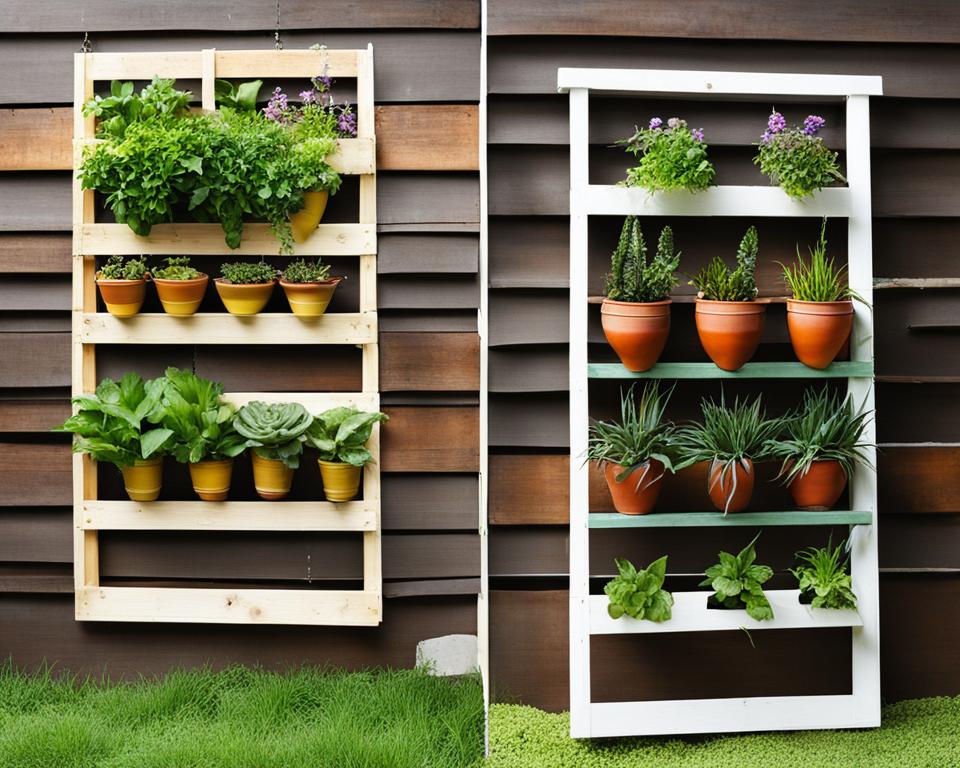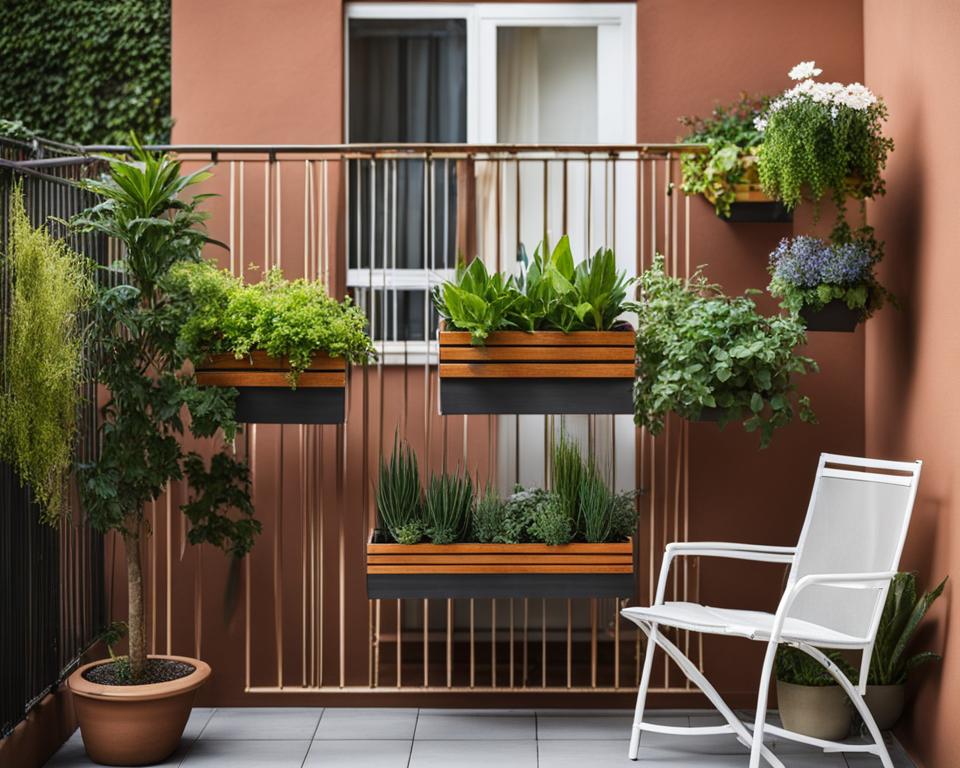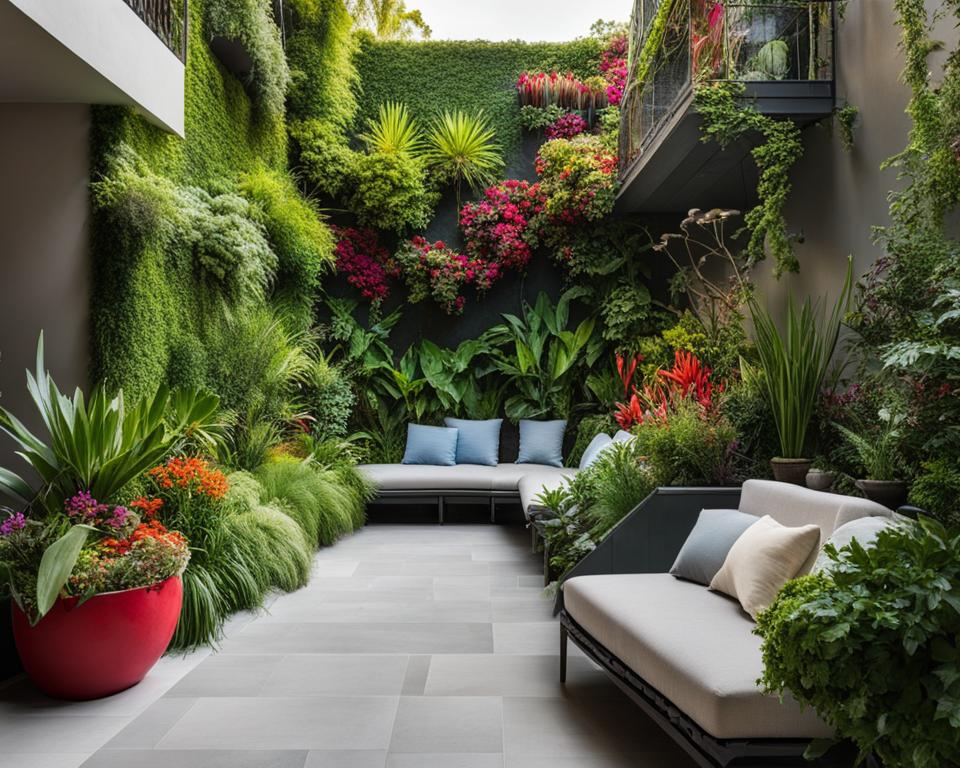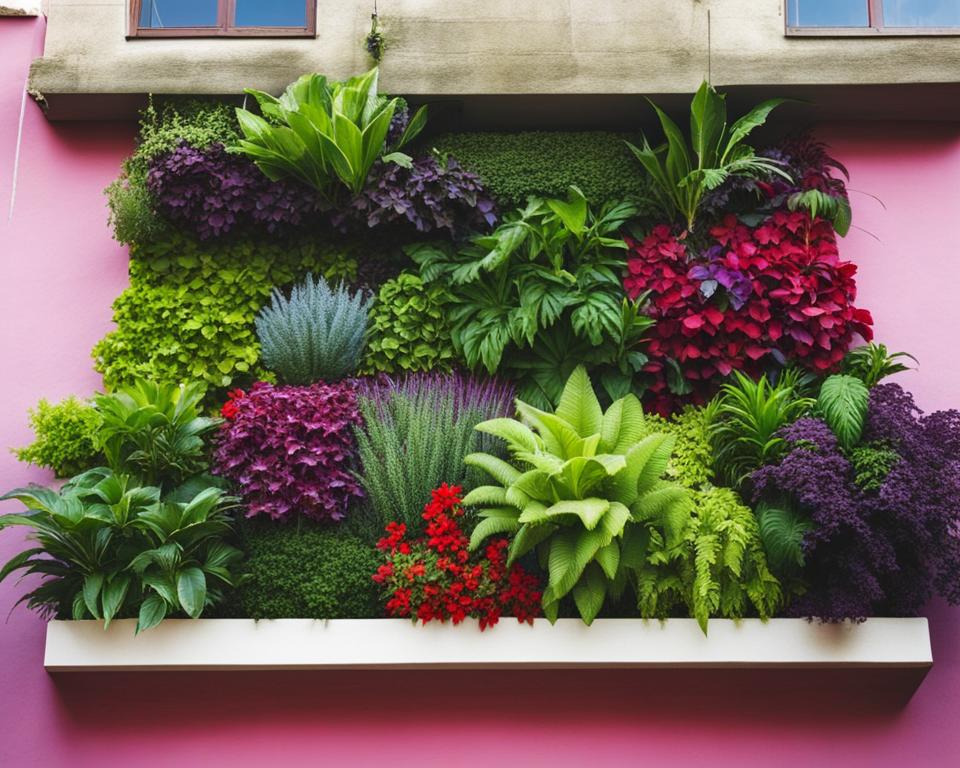Welcome to my article on innovative vertical garden ideas that will help you transform any space into a lush and vibrant oasis. Vertical gardening has become increasingly popular as it offers a versatile and sustainable way to grow plants in limited spaces.
Whether you have a small balcony, rooftop patio, or large backyard, vertical gardening can help you maximize your space and add a touch of greenery to your surroundings. In this article, I will share a variety of vertical gardening ideas that can be implemented in any space, from DIY projects to creative solutions for small spaces.
Get ready to explore a world of possibilities with these innovative vertical garden ideas!
Key Takeaways:
- Vertical gardening offers a versatile and sustainable way to grow plants in limited spaces.
- There are many innovative vertical garden ideas that can be implemented in any space, from DIY projects to creative solutions for small spaces.
- Vertical gardening can help you maximize your space and add a touch of greenery to your surroundings.
- Explore a world of possibilities with these innovative vertical garden ideas.
- Stay tuned for more tips and techniques on how to create a stunning vertical garden in your space!
Transform Walls and Fences into Lush Edible Landscapes
If you have limited space but still want to enjoy the benefits of gardening, vertical gardening is the answer. With the right vertical gardening ideas, you can transform walls and fences into stunning edible landscapes.
One of the best vertical garden designs is the living wall. A living wall is a wall that is covered with vegetation, creating a green and lush surface that adds beauty to any space. Living walls can be made from a variety of materials, including wood, metal, and concrete.
For those who want a more traditional look, a trellis is a great option. A trellis is a framework of interwoven wooden or metal bars that plants can climb on. This option is perfect for those who want to grow climbing vegetables like tomatoes, cucumbers, and beans.
If you want to add a unique touch to your vertical garden, consider using repurposed materials. An old ladder, for instance, can be transformed into a vertical herb garden by hanging pots from the rungs. This creative solution is not only sustainable but also adds character to your space.
Another innovative vertical garden idea is the use of hydroponics. Hydroponics is a method of growing plants without soil, using nutrient-rich water instead. This technique is perfect for small spaces and allows you to grow a wide variety of plants, including fruits and vegetables.
Regardless of the vertical gardening idea you choose, it’s important to plan your vertical garden carefully. Consider factors such as sunlight, water, and soil requirements to ensure your plants thrive. With the right planning and execution, you can transform any wall or fence into a lush and beautiful edible landscape.
DIY Vertical Garden Projects for a Personal Touch
If you’re looking for a fun and creative way to enhance your outdoor space, DIY vertical gardens are the perfect solution. Not only do they add a touch of nature to your surroundings, but they’re also a great way to showcase your personality and gardening skills.
There are countless DIY vertical garden projects that you can try, from simple wall planters to unique repurposed items. One of my favorite ideas is to use old pallets as a base for a vertical garden. Simply attach small planters or pots to the pallet, add soil and your favorite plants, and hang the pallet on a wall or fence. It’s a great way to upcycle and add some rustic charm to your space.

If you’re feeling more adventurous, you can try creating a vertical garden from scratch using PVC pipes or gutters. Simply drill small holes in the pipes or gutters, fill with soil, and add plants. You can even paint the pipes or gutters to match your decor.
Another fun DIY project is to repurpose a wooden ladder into a vertical herb garden. Simply add small pots or containers to the rungs, fill with soil, and plant your favorite herbs. It’s a unique and charming way to add some greenery to your space.
Tips for Creating DIY Vertical Gardens
- Choose plants that are well-suited for vertical growth, such as succulents, herbs, and trailing vines.
- Make sure to use a good quality soil that will retain moisture and provide essential nutrients for your plants.
- Consider the location of your DIY vertical garden – make sure it will get enough sunlight and won’t be obstructed by other objects.
- Water your DIY vertical garden regularly – depending on the type of plants you chose, you may need to water them daily.
- Get creative with your planters and decor – consider using repurposed items like old tin cans or glass jars to add some personality to your vertical garden.
Creating a DIY vertical garden is a fun and rewarding project that can enhance the beauty of your outdoor space. With a little creativity and some basic gardening skills, you can transform any wall or fence into a lush and vibrant oasis.
Small Space Vertical Gardening Solutions
Living in a small space doesn’t mean giving up on gardening. With vertical gardening, you can transform your small balcony, patio or even a windowsill into a green oasis. I have compiled some innovative and space-saving vertical gardening ideas to help you make the most of your limited outdoor areas.
First, consider utilizing a hanging herb garden. With a few hooks and some hanging planters, you can easily create a beautiful and functional herb garden without taking up valuable floor space. Not only will it freshen up your space, but it will also provide you with fresh herbs for cooking.

If you have a wall that receives plenty of sunlight, create a vertical garden with the help of a trellis or vertical garden planter. These planters allow you to grow a variety of plants in a small space and can easily be hung from a wall or even placed on a tabletop. Some vertical planters even include a built-in watering system, making plant care a breeze.
If you want to grow vegetables, consider a vertical vegetable garden. Utilizing a trellis or other vertical structure, you can grow a variety of vegetables, such as tomatoes, cucumbers, and beans. Not only will it save space, but it can also help prevent pests and disease by keeping the plants off the ground.
Comparing Small Space Vertical Gardening Solutions
| Vertical Gardening Solution | Benefits | Drawbacks |
|---|---|---|
| Vertical hanging herb garden | Space-saving, functional, and decorative | Requires regular watering and care |
| Vertical garden planter | Allows for a variety of plants in a small space, built-in watering system makes plant care easy | May be more expensive than other options |
| Vertical vegetable garden | Saves space, helps prevent pests and disease | May require more maintenance and care than other solutions |
No matter which small space vertical gardening solution you choose, be sure to select plants that thrive in your specific growing conditions. Consider the amount of sunlight your space receives, as well as the type of soil and drainage. With the right plants and a little creativity, you can create a stunning vertical garden that fits perfectly in your small space.
Vertical Gardening for Beginners: Tips and Techniques
If you’re new to vertical gardening, it can seem overwhelming. However, with the right tips and techniques, anyone can start creating their own stunning vertical garden.
Choosing the Right Plants
The first step in vertical gardening is to choose the right plants for your space and climate. Consider factors such as the amount of sunlight, humidity, and temperature in your area. Some popular vertical garden plants include:
- Herbs: Basil, Mint, Thyme, Rosemary, etc.
- Succulents: Aloe Vera, Echeveria, Jade Plant, etc.
- Flowers: Petunias, Pansies, Begonias, etc.
- Fruits and Vegetables: Tomatoes, Cucumbers, Strawberries, etc.
Choosing the right plants with similar needs ensures that they thrive in your vertical garden, giving it a beautiful and healthy appearance.
Soil Preparation
Soil preparation is key to the success of your vertical garden. Use high-quality soil that drains well. This is particularly important in vertical gardens as moisture can build up in the structure. Adding compost to the soil improves its quality and helps retain moisture.
Watering Guidelines
Proper watering is essential to the health of your plants. Vertical gardens require more frequent watering than traditional gardens due to the limited soil capacity. A drip irrigation system or self-watering planter can help regulate watering and ensure your plants receive an adequate amount of moisture.

Other Techniques
There are several techniques that can help enhance your vertical garden, such as:
- Adding trellises or stakes to support climbing plants
- Using recycled materials such as pallets or guttering to create a vertical garden
- Planting in a variety of containers such as hanging baskets, pots, or wall-mounted planters
In Summary
Vertical gardening is a fun and innovative way to maximize your outdoor space. With the right plants, soil preparation, and watering techniques, you can create a stunning vertical garden that is sure to impress. Don’t be afraid to experiment with different ideas and techniques to make your vertical garden unique and beautiful.
Creative Vertical Garden Solutions for Unique Spaces
If you have a unique, unconventional space that you want to transform into a lush green paradise, then I have some innovative vertical gardening ideas for you. These creative solutions will allow you to incorporate greenery into your space and make a statement with your vertical garden.
Repurposed Items
One great way to add a personal touch to your vertical garden is by repurposing everyday items into planters. For example, you can use old tin cans, mason jars, or even rain boots as planters. Just be sure to add drainage holes to prevent overwatering and root rot.

Living Art
If you want to make a statement with your vertical garden, consider creating a living art installation. One way to do this is by using succulents to create a vertical garden on a canvas or wooden frame. This unique piece of living art will add texture and color to your space and act as a conversation starter for guests.
Vertical Water Garden
Take your vertical garden to the next level by incorporating water features into the design. You can create a beautiful and tranquil space by adding a vertical water garden to your wall. Simply add aquatic plants to the pockets of a vertical garden planter and include a water pump and reservoir to circulate the water.
Outdoor Chandelier
If you have an outdoor dining or seating area, consider adding an outdoor chandelier planter to your vertical garden. This will create a unique, cozy atmosphere and add a touch of elegance to your space. To create this planter, hang a wire basket chandelier and fill it with your favorite plants and flowers.
Vertical Vegetable Garden
If you’re short on space but still want to enjoy fresh produce, consider creating a vertical vegetable garden. You can use a variety of materials, such as pallets or PVC pipes, to create a vertical garden planter for your vegetables. This will not only save space but also allow you to enjoy fresh produce right from your own garden.
These creative vertical garden solutions are just the beginning. With some imagination and a little DIY know-how, you can transform any space into a stunning, lush green oasis.
Innovative Vertical Garden Ideas for Sustainable Living
Vertical gardening is not just about creating beautiful outdoor spaces; it’s also a sustainable way to live. With innovative vertical garden ideas, you can promote eco-friendly practices and reduce your carbon footprint. Here are some ideas to get you started:
Vertical Garden Integrated with Rainwater Harvesting System
Don’t let rainwater go to waste; incorporate it into your vertical garden with a rainwater harvesting system. This system collects rainwater, which can then be used to water your plants. It’s a simple solution that saves water and reduces your water bill.
Vertical Garden Composting Solution
Composting is an easy way to reduce waste while enriching your soil. By adding a composting solution to your vertical garden, you can turn kitchen scraps and yard waste into nutrient-rich soil for your plants. It’s a win-win for the environment and your garden.
Vertical Garden Solar-Powered Irrigation System
Running irrigation systems can be expensive and taxing on the environment. With a solar-powered irrigation system, you can water your plants without the high cost and environmental impact. This system uses solar power to pump water from a storage tank to your vertical garden.
Vertical Garden Green Roof
Turn your rooftop into a green space with a vertical garden green roof. This solution not only reduces heat island effect and CO2 emissions, but it also improves air quality and biodiversity. It’s a beautiful and sustainable addition to any urban environment.
Vertical Garden Beehive
Support local pollinators by adding a beehive to your vertical garden. Bees play a crucial role in pollinating plants and maintaining biodiversity. By creating a bee-friendly environment, you’re not only helping the ecosystem, but you’re also creating a unique and beautiful vertical garden.
With these innovative vertical garden ideas, you can create a sustainable and eco-friendly oasis that benefits both you and the environment. Get creative and start exploring these ideas to transform your space.
Incorporating Vertical Gardening into Urban Environments
As cities continue to grow, urban environments can feel like concrete jungles devoid of nature. However, incorporating vertical gardening can transform these spaces into green oases that benefit both humans and the planet.
Vertical Gardens in Community Spaces
Community spaces such as parks and public plazas can benefit from the addition of vertical gardens. These installations provide a visual and sensory experience for visitors while also improving air quality and reducing noise pollution. According to a study by the University of Technology Sydney, vertical gardens can reduce noise levels by as much as 10 decibels.
Rooftop Gardens
Rooftop gardens are an innovative way to incorporate vertical gardening into urban environments, providing a natural escape from the hustle and bustle of city life. These gardens can help reduce the urban heat island effect by cooling the air and providing shade, resulting in lower energy consumption and costs.
Additionally, rooftop gardens can help mitigate the negative environmental impacts of urbanization by improving stormwater management and reducing air pollution. In fact, a study by the National Research Council of Canada found that a one-acre green roof can capture as much as 10,000 gallons of water during a one-inch rainfall event.
Urban Balconies
Even if you don’t have access to a public space or rooftop, you can still incorporate vertical gardening into your urban living space. Urban balconies are a perfect place to add some greenery to your home while also creating a private outdoor oasis.
One innovative vertical gardening idea for balcony spaces is the use of vertical planters, which allow you to grow plants from a vertical surface. These planters come in a variety of sizes and can be used to grow anything from herbs to flowers to vegetables.
Sustainable Benefits
Incorporating vertical gardening into urban environments provides many sustainable benefits, including reducing the urban heat island effect, improving air and water quality, and increasing biodiversity. Additionally, vertical gardens can serve as a source of fresh produce in urban food deserts, helping to promote food security and access to healthy foods.
Overall, vertical gardening is an innovative and sustainable solution for transforming urban environments into green oases that benefit both humans and the planet.
Innovative Vertical Garden Ideas for Sustainable Living
If you’re passionate about eco-friendly practices and sustainability, I have some exciting vertical gardening ideas to share with you. These innovative ideas combine the beauty of vertical gardens with practical features that promote responsible living.
Vertical Gardens with Rainwater Harvesting Systems
One of the most effective ways to reduce water waste is by incorporating a rainwater harvesting system into your vertical garden. This system collects rainwater in a storage tank, which can then be used to water your plants, reducing your water bills and promoting sustainable living. You can create a rainwater harvesting system using simple DIY techniques or purchase a pre-made system.
Composting Solutions for Vertical Gardens
Composting is an easy and effective way to reduce food waste and nourish your plants. Adding a composting solution to your vertical garden can turn food scraps and other organic materials into nutrient-rich soil. You can create a composting bin that fits into your vertical garden design or purchase a pre-made composting solution.
Vertical Gardens with Solar-Powered Watering Systems
Solar-powered watering systems are a great way to promote sustainable living and reduce your energy bills. These systems use solar panels to power a pump that waters your plants, eliminating the need for electricity. You can create your own solar-powered watering system using DIY techniques or purchase a pre-made system.
Vertical Gardens with LED Grow Lights
LED grow lights are an energy-efficient way to provide your plants with the light they need to thrive. These lights use less energy than traditional grow lights and can be customized to provide the ideal spectrum of light for your plants. Incorporating LED grow lights into your vertical garden can help you reduce your energy bills and promote sustainable living.
Vertical Gardens with Air Purifying Plants
Air purifying plants are a natural way to improve the air quality in your home or outdoor space. These plants absorb toxins and pollutants from the air, promoting a healthier living environment. You can incorporate air purifying plants into your vertical garden design, creating a beautiful and practical addition to your space.
These innovative vertical garden ideas offer practical solutions for sustainable living, while also enhancing the beauty and functionality of your outdoor space. Whether you’re passionate about eco-friendly practices or simply looking for practical ways to enhance your vertical garden, these ideas are sure to inspire you.
Conclusion
As a professional copywriting journalist, I hope that this article has provided you with a plethora of vertical gardening ideas that can be implemented in any space. From transforming walls and fences into lush edible landscapes to exploring DIY projects for a personal touch, vertical gardening offers endless possibilities for creative expression and sustainable living.
If you’re new to vertical gardening, don’t fret! In this article, I’ve provided tips and techniques that are perfect for beginners. Whether you have limited outdoor space or want to create a vertical garden indoors, these innovative ideas will help you make the most of your space and enhance your living environment.
Start Your Vertical Garden Today
With these ideas and inspirations, there’s no reason not to start your own vertical garden today. Remember, vertical gardening not only offers a visually stunning display but also promotes sustainable living and eco-friendly practices.
So, whether you’re a seasoned gardener or just starting out, I encourage you to explore these ideas and take the first step in transforming your space into a lush and vibrant oasis. Happy gardening!
FAQ
What is vertical gardening?
Vertical gardening is a technique that involves growing plants vertically, either on walls, fences, or in specially designed structures. It maximizes space and allows for creative and unique garden designs.
What are the benefits of vertical gardening?
Vertical gardening has several benefits, such as maximizing space utilization, adding visual interest, improving air quality, reducing urban heat island effect, and providing a sustainable way to grow plants even in limited areas.
Do I need any special equipment for vertical gardening?
The equipment needed for vertical gardening may vary depending on the specific project. However, some common tools include wall planters, trellises, hanging baskets, vertical planters, irrigation systems, and sturdy supports for climbers.
Can I grow vegetables in a vertical garden?
Yes, vertical gardens are an excellent way to grow vegetables. Many vegetable plants, such as tomatoes, cucumbers, peppers, and herbs, thrive in vertical gardening systems. Just make sure to choose suitable varieties and provide adequate support.
How do I maintain a vertical garden?
Regular maintenance is crucial for the success of a vertical garden. It involves watering, fertilizing, pruning, and monitoring for pests or diseases. Depending on the type of plants and the specific system used, maintenance tasks may vary.
Can I have a vertical garden indoors?
Yes, vertical gardens can be adapted to indoor spaces. You can create living walls, use hanging planters, or even set up vertical herb gardens in your kitchen. Just make sure to choose suitable plants that thrive in indoor conditions.
How much sunlight do plants in a vertical garden need?
The sunlight requirements will depend on the specific plants you choose for your vertical garden. Generally, most plants require at least 4-6 hours of direct sunlight per day. However, there are also shade-tolerant plants that can thrive in low-light conditions.
Are there any specific plants that are well-suited for vertical gardening?
There are many plant varieties that work well in vertical gardening, such as climbing roses, ivy, ferns, succulents, herbs, strawberries, and ornamental grasses. It’s essential to consider the light, climate, and growing conditions of your specific area when selecting plants.
How can I make my vertical garden more sustainable?
To make your vertical garden more sustainable, you can incorporate eco-friendly practices such as rainwater harvesting, composting, using organic fertilizers, and choosing native or drought-tolerant plants. These practices can help conserve resources and promote a greener environment.
Can I create a vertical garden on a balcony or small outdoor space?
Absolutely! Vertical gardening is an excellent solution for small outdoor spaces like balconies or patios. You can utilize walls, railings, or hang planters to maximize the vertical space and create a lush green oasis even in limited areas.

